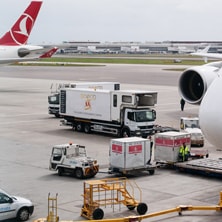
Airport capacity is often stretched beyond its limits. One of AiQ’s Consultancy services allows us to view challenges from all angles, providing capacity solutions that the client may not have considered, and, offering insights that increase their operational efficiency without the need for additional investment.
Read on for case studies showing our holistic approach to airport capacity planning, and the results it can achieve.
Case Study 1: Ground Service Equipment (GSE) at London Heathrow
AiQ Consulting provided decision support for HAL at one of the busiest airport hubs in the world. This was to introduce the shared Ground Service Equipment (GSE) concept with the aim to gain operational efficiency at airside operations.
In order to achieve this, we gathered GSE data covering Terminals 2, 3 and 4 and established both ‘Current’ and ‘Common’ GSE volumes across those terminals. This highlighted GSE patterns amongst ground handlers in each terminal and as a result we were able to devise required GSE volumes in each terminal.
Consequently, the client was able to increase operation efficiency based on predicted volumes and activity.
Case Study 2: Large Aircraft Congestion at London Heathrow
The introduction of larger aircraft with greater capacity (for example the Airbus A380) could have caused congestion at apron that ultimately could lead to an increased number of vehicles on certain roads at airside. To establish efficient routes to the aircraft from baggage hall etc. whilst reducing congestion, AiQ carried out an airside vehicle simulation to solve the problem.
Using flight schedules, we conducted an airside vehicle demand analysis for our client to understand the impact of these larger aircraft. We developed a complex simulation model integrating vehicle types and their engagement standards, geographical locations of handlers, ULD empty/full storage as well as airlines and more. Using this simulation, we were able to communicate clearly with the customer and other stakeholders the increased traffic flow, as well as the critical path surrounding predicted problems and delays in the turnaround process.
This increased understanding and stakeholder management, allowed the client, ground handlers and airlines to work together for increased operational efficiency.
Case Study 3: Analysis of Cargo Vehicle Operations at LHR
As a result of the introduction of larger aircraft; cargo operators also exposed their markets, mixing passengers with cargo on larger aircraft. This increased the complexity of logistics at airports.
To maintain a greater fleet of lorries to cope with such demand, we were asked by Swissport to carry out an analysis of their cargo Vehicle operations at LHR. Successful research was carried out by exploring the following:
- Vehicle attendance based on Swissport Apron Activity reports and Vehicle Registration details provided. Averages for each airline were used as well as averages based on destination and flight numbers, when available.
- Vehicle journey times, as well as loading/unloading times based on data provided.
- Analysis based on provided schedule for a peak day in Winter 2014.
This insight allowed the client to plan their HGV schedules more efficiently, coping with the increased demand.
Read more about Airport Operational Efficiency Planning and our other Airport Consultancy Services.

